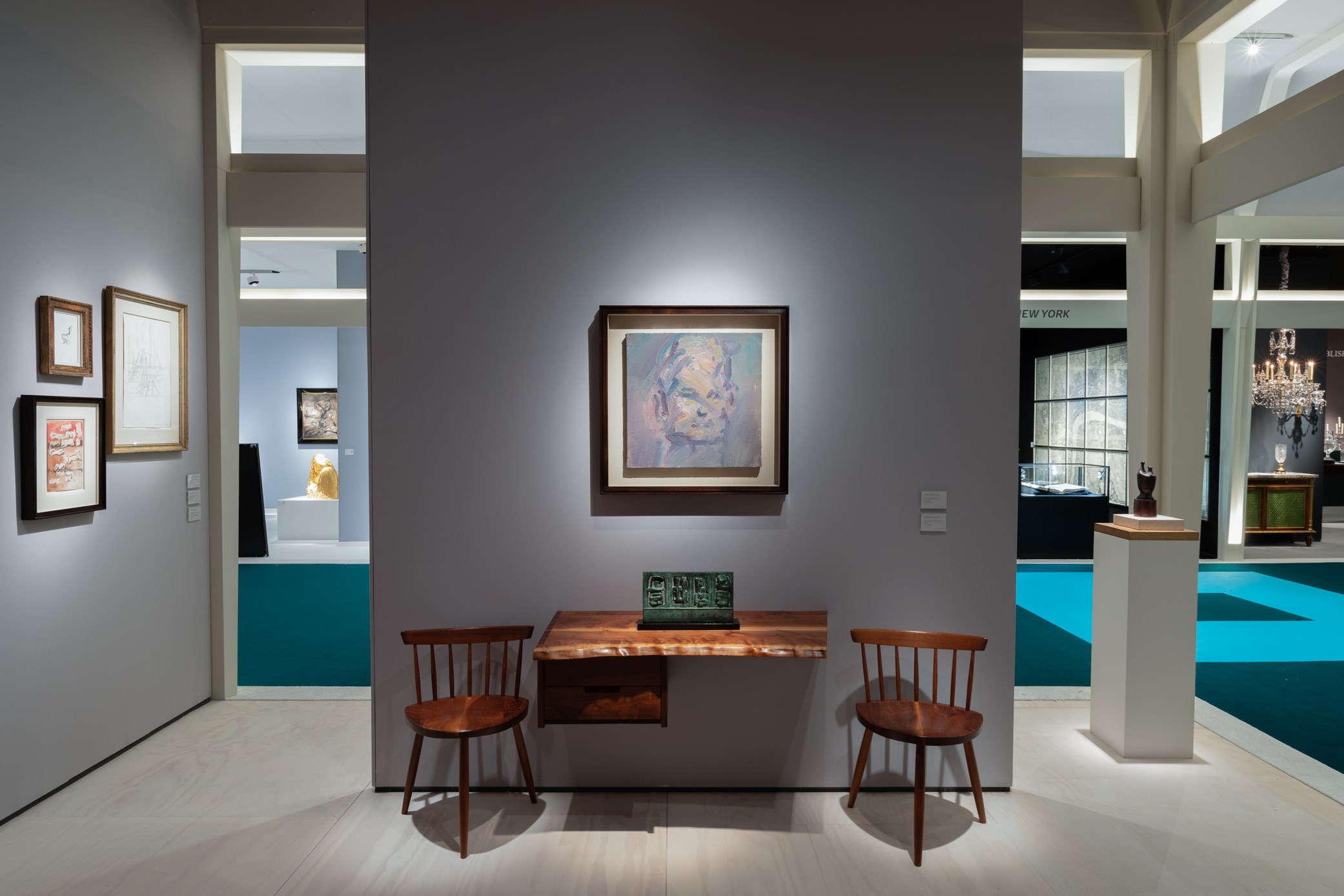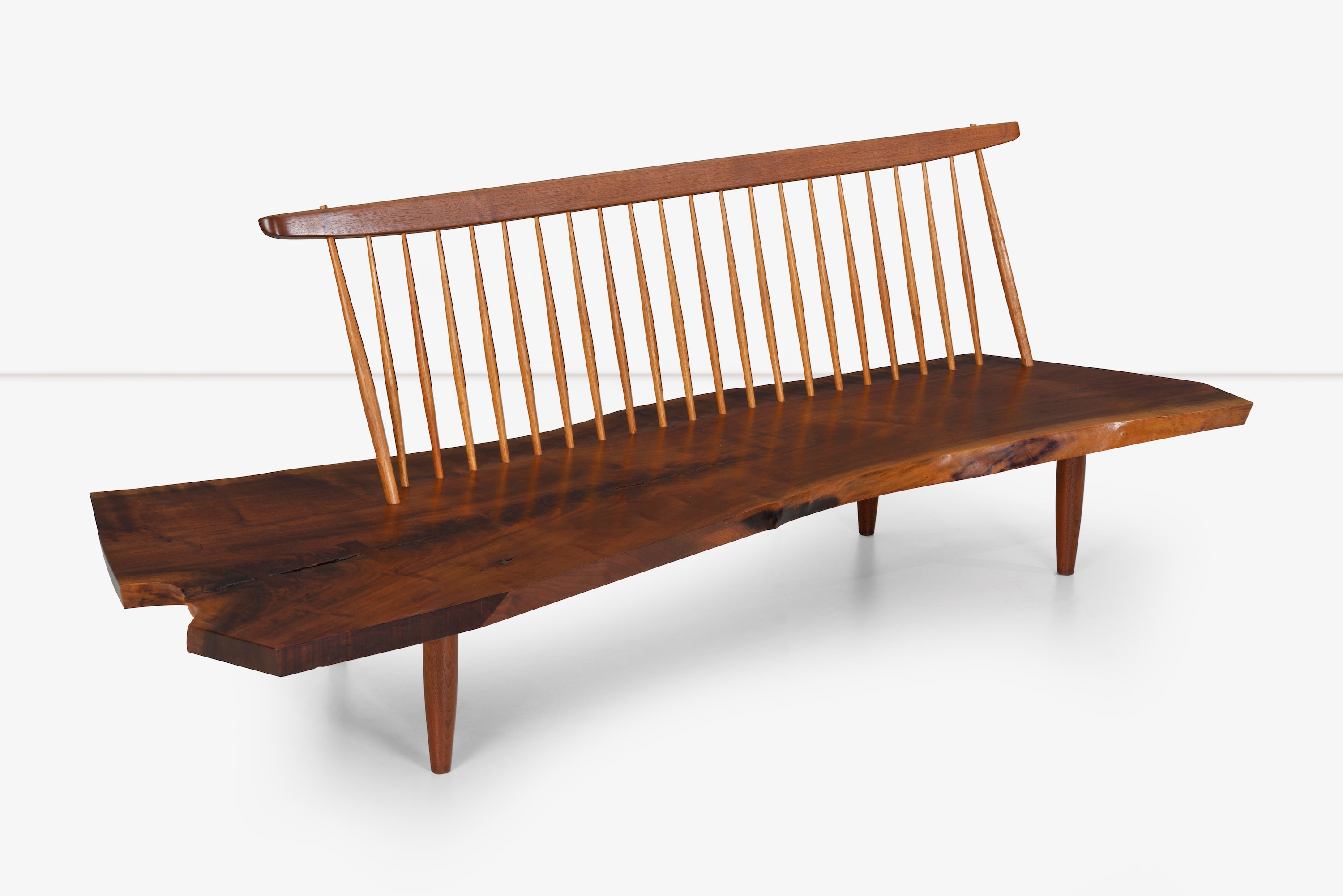American Craft in collectors' hearts
14 September 2023
Share
How the the humble genre swept its way to the highest ranks of the art world becoming one of the most sought after movements in contemporary design and woodwork.
By Emma Crichton-Miller
Twenty years ago, Robert Travers of the London Modern British gallery Piano Nobile told me; “I was at Sotheby’s for a sale, when I walked through another sale of Modern Design. I saw a table. It was very splendid. I discovered it was by George Nakashima.”
From that point, Travers began to collect good pieces when he came upon them, and indeed deal in them: “I like that East meets West aesthetic and Nakashima’s lovely feel for natural timber.” These have become an essential part of the gallery’s display of their roster of Modern British artists, both in the gallery and at art fairs. Travers comments; “The furniture is not too extreme, but there is this quiet intensity of engagement with the material that is complementary to our pictures.”
 George Nakashima Floating Shelf and Frank Auerbach portrait of David Landau at Piano Nobile's stand at The Treasure House Fair 2023
George Nakashima Floating Shelf and Frank Auerbach portrait of David Landau at Piano Nobile's stand at The Treasure House Fair 2023
Image courtesy of PIANO NOBILE, London.
Today, the market of the Japanese American woodworker, architect and furniture maker, is flourishing. George Nakashima, born in the US in 1905, is widely acknowledged to be the founder of the American Studio Craft Furniture movement, which had its birth in the rural artists' colony of New Hope, Pennsylvania, in the 1940s. After travelling the world as a young man, including stints working as an architect and designer in Japan and India, it was in an internment camp in Idaho that Nakashima met the Japanese master carpenter Gentaro Hikogawa and began to apply himself to making one-off pieces of hand-crafted furniture, using traditional Japanese joinery techniques. In 1943, the American architect Antonin Raymond successfully sponsored Nakashima’s release from the camp and invited him to his farm in New Hope, Pennsylvania. There, in his studio and workshop, Nakashima began to explore the organic expressiveness of wood, and embarked on his hunt for timbers with ever more dynamic knots and burls and figured grains. While he constructed many different kinds of distinctive furniture, he is best known for his large tables made from giant slices of tree, sometimes entire, sometimes linked by butterfly joints, with the natural edge of the trunk creating the contoured edge of the table.
_T638302055782981928.jpg) Minguren II Coffee Table by George Nakashima
Minguren II Coffee Table by George Nakashima
One of the world’s most renowned specialist dealers in the work of Nakashima, is Washington DC-based Geoffrey Diner. His own exemplary cross-disciplinary collecting provides a model for how great art and great design converse together. Growing up in Buffalo, New York, where the leaders of the American Arts & Crafts Movement were highly regarded, he expanded his interest through the 1980s to British Arts and Crafts, as well as contemporary makers. Today, his focus is post-war art and design, and his outstanding display of fine pieces at Treasure House Fair in 2023 included a highly desirable Nakashima Conoid Bench, with split seat and stick back, from 1973, and a monumental “Minguren II” Coffee Table.
_T638302047676368205.jpg) Unique three-seater sofa by Wendell Castle
Unique three-seater sofa by Wendell Castle
Stack laminated walnut, leather, 1974
Image courtesy of Phillips
 Conoid Bench by George Nakashima
Conoid Bench by George Nakashima
Image courtesy of Geoffrey Diner Gallery
Nakashima drew equally on his Japanese heritage and North America’s distinguished Arts and Crafts tradition. Already Wharton Esherick, born in 1889, had begun to work by hand with wood in the 1920s. He was followed by Phillip Lloyd Powell on the East Coast, while on the West Coast Sam Maloof, Jack Rogers Hopkins and Arthur Espenet Carpenter formed another group. A second generation included the daring sculptural designers Paul Evans (1931-1987), and Wendell Castle (1932-2018), Judy Hensley McKie (b.1944) and Mira Nakashima (b.1942), George’s daughter, who for many years continued to oversee production of furniture in her father’s workshop alongside making her own work. Each pursued their own personal aesthetic, using a wide range of materials, but rooted in a dedication to hand processes - whether the sensuous wood carving of Wendell Castle or Paul Evans’s sculpted metalwork.
_T638302061963186752.jpg)
Geoffrey Diner Gallery at The Treasure House Fair 2023
Image Courtesy of The Treasure House Fair
Leading collectors of the day - including Nelson Rockefeller, Stephen Spielberg and Diane von Furstenberg - bought enthusiastically, alongside many homemakers who saw in these makers’ work a rebuff to modern mass-production. In 1973, Nelson Rockefeller commissioned two hundred pieces from Nakashima alone for his house in Pocantico Hills, New York. During the 1980s, however, the work of the studio craft makers fell out of fashion. Indeed, Robert Aibel of Moderne Gallery in Philadelphia, a leading gallery for American Studio Craft Furniture, remembers buying a Nakashima dining table and chairs in 1985 for $3000 from a doctor who referred to it as “used furniture.” Aibel had an instinct that there was a market out there, however, and, slowly, the market rebuilt, until the dizzying heights of the early 2000s, when, in December 2006, at Sotheby’s New York, a beautifully patterned, wildly irregular table made from a single cross-section slice of redwood burl, created by Nakashima in 1988 for his patrons, Dr. Arthur and Evelyn Krosnick of Princeton, New Jersey sold for $822,400. Since then, other notable auction records include the £225,000 paid for the unique stack-laminated walnut three-seater sofa by Wendell Castle, from 1974, achieved at Phillips London in April 2018, and the $382,000 paid in 2017 at Rago Arts and Auction for a 1977 Paul Evans cabinet.
By Emma Crichton-Miller
Twenty years ago, Robert Travers of the London Modern British gallery Piano Nobile told me; “I was at Sotheby’s for a sale, when I walked through another sale of Modern Design. I saw a table. It was very splendid. I discovered it was by George Nakashima.”
From that point, Travers began to collect good pieces when he came upon them, and indeed deal in them: “I like that East meets West aesthetic and Nakashima’s lovely feel for natural timber.” These have become an essential part of the gallery’s display of their roster of Modern British artists, both in the gallery and at art fairs. Travers comments; “The furniture is not too extreme, but there is this quiet intensity of engagement with the material that is complementary to our pictures.”
 George Nakashima Floating Shelf and Frank Auerbach portrait of David Landau at Piano Nobile's stand at The Treasure House Fair 2023
George Nakashima Floating Shelf and Frank Auerbach portrait of David Landau at Piano Nobile's stand at The Treasure House Fair 2023Image courtesy of PIANO NOBILE, London.
Today, the market of the Japanese American woodworker, architect and furniture maker, is flourishing. George Nakashima, born in the US in 1905, is widely acknowledged to be the founder of the American Studio Craft Furniture movement, which had its birth in the rural artists' colony of New Hope, Pennsylvania, in the 1940s. After travelling the world as a young man, including stints working as an architect and designer in Japan and India, it was in an internment camp in Idaho that Nakashima met the Japanese master carpenter Gentaro Hikogawa and began to apply himself to making one-off pieces of hand-crafted furniture, using traditional Japanese joinery techniques. In 1943, the American architect Antonin Raymond successfully sponsored Nakashima’s release from the camp and invited him to his farm in New Hope, Pennsylvania. There, in his studio and workshop, Nakashima began to explore the organic expressiveness of wood, and embarked on his hunt for timbers with ever more dynamic knots and burls and figured grains. While he constructed many different kinds of distinctive furniture, he is best known for his large tables made from giant slices of tree, sometimes entire, sometimes linked by butterfly joints, with the natural edge of the trunk creating the contoured edge of the table.
_T638302055782981928.jpg) Minguren II Coffee Table by George Nakashima
Minguren II Coffee Table by George Nakashima
Image Courtesy of PIANO NOBILE, London.
_T638302058807174966.jpg) Detail of butterfly joint on Minguren II Coffee Table by George Nakashima
Detail of butterfly joint on Minguren II Coffee Table by George Nakashima
Image courtesy of PIANO NOBILE, London._T638302058807174966.jpg) Detail of butterfly joint on Minguren II Coffee Table by George Nakashima
Detail of butterfly joint on Minguren II Coffee Table by George NakashimaOne of the world’s most renowned specialist dealers in the work of Nakashima, is Washington DC-based Geoffrey Diner. His own exemplary cross-disciplinary collecting provides a model for how great art and great design converse together. Growing up in Buffalo, New York, where the leaders of the American Arts & Crafts Movement were highly regarded, he expanded his interest through the 1980s to British Arts and Crafts, as well as contemporary makers. Today, his focus is post-war art and design, and his outstanding display of fine pieces at Treasure House Fair in 2023 included a highly desirable Nakashima Conoid Bench, with split seat and stick back, from 1973, and a monumental “Minguren II” Coffee Table.
_T638302047676368205.jpg) Unique three-seater sofa by Wendell Castle
Unique three-seater sofa by Wendell CastleStack laminated walnut, leather, 1974
Image courtesy of Phillips
 Conoid Bench by George Nakashima
Conoid Bench by George NakashimaImage courtesy of Geoffrey Diner Gallery
Nakashima drew equally on his Japanese heritage and North America’s distinguished Arts and Crafts tradition. Already Wharton Esherick, born in 1889, had begun to work by hand with wood in the 1920s. He was followed by Phillip Lloyd Powell on the East Coast, while on the West Coast Sam Maloof, Jack Rogers Hopkins and Arthur Espenet Carpenter formed another group. A second generation included the daring sculptural designers Paul Evans (1931-1987), and Wendell Castle (1932-2018), Judy Hensley McKie (b.1944) and Mira Nakashima (b.1942), George’s daughter, who for many years continued to oversee production of furniture in her father’s workshop alongside making her own work. Each pursued their own personal aesthetic, using a wide range of materials, but rooted in a dedication to hand processes - whether the sensuous wood carving of Wendell Castle or Paul Evans’s sculpted metalwork.
_T638302061963186752.jpg)
Geoffrey Diner Gallery at The Treasure House Fair 2023
Image Courtesy of The Treasure House Fair
Leading collectors of the day - including Nelson Rockefeller, Stephen Spielberg and Diane von Furstenberg - bought enthusiastically, alongside many homemakers who saw in these makers’ work a rebuff to modern mass-production. In 1973, Nelson Rockefeller commissioned two hundred pieces from Nakashima alone for his house in Pocantico Hills, New York. During the 1980s, however, the work of the studio craft makers fell out of fashion. Indeed, Robert Aibel of Moderne Gallery in Philadelphia, a leading gallery for American Studio Craft Furniture, remembers buying a Nakashima dining table and chairs in 1985 for $3000 from a doctor who referred to it as “used furniture.” Aibel had an instinct that there was a market out there, however, and, slowly, the market rebuilt, until the dizzying heights of the early 2000s, when, in December 2006, at Sotheby’s New York, a beautifully patterned, wildly irregular table made from a single cross-section slice of redwood burl, created by Nakashima in 1988 for his patrons, Dr. Arthur and Evelyn Krosnick of Princeton, New Jersey sold for $822,400. Since then, other notable auction records include the £225,000 paid for the unique stack-laminated walnut three-seater sofa by Wendell Castle, from 1974, achieved at Phillips London in April 2018, and the $382,000 paid in 2017 at Rago Arts and Auction for a 1977 Paul Evans cabinet.

